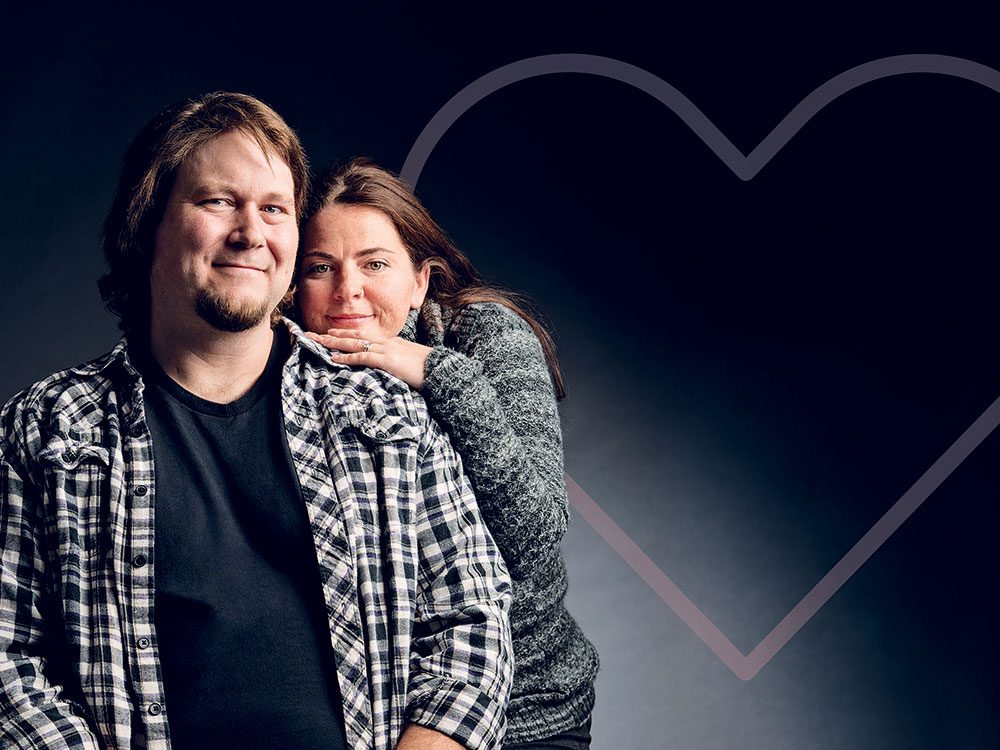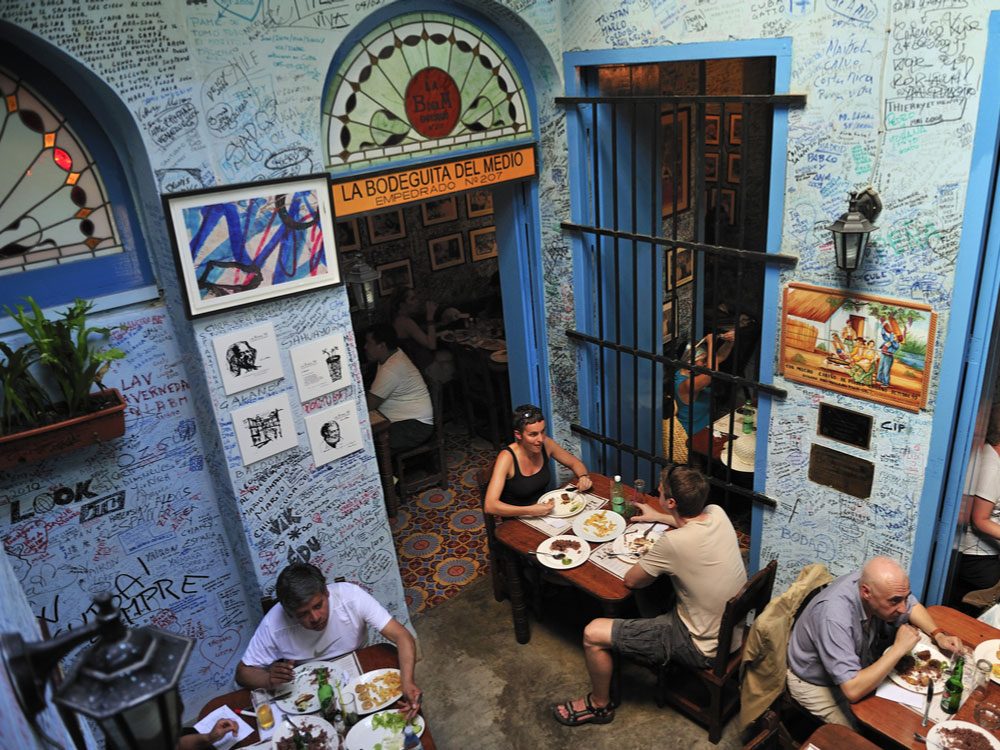
Love on the Heart Transplant List
In a private wing of Winnipeg’s airport, an air ambulance was prepping to take Russell MacDougall to Ottawa, where a new heart was waiting. Until this point, the 35-year-old—convinced that a donor wouldn’t be found in time to save him—had been focused on spending his last remaining weeks with his family. That morning, April 29, 2015, after recovering from the shock of the call about the imminent transplant, MacDougall said goodbye to his 14-year-old son, Declan, and 11-year-old daughter, Kaylyn. He was now absorbed by the upcoming high-risk operation, but he had one more important thing to do before he left. “Let’s go for a walk,” he suggested to his girlfriend, Sherene Wright, 36, leading her outside. Dropping down to one knee on the warm pavement, he pulled out a white-gold diamond solitaire ring.
“I’ll marry you, but you’re probably not going to remember proposing to me when you wake up,” Wright teased. She knew all about the brain fog caused by anesthesia. Three years earlier, Wright had received her own transplant. In fact, a broken heart is what led to the love of her life. (Here are 10 risk factors for heart disease.)
On average, fewer than 200 people receive heart transplants in Canada every year, according to the Canadian Institute for Health Information (CIHI), which tracks the statistics. The odds of cardiac failure turning into a meet-cute are astronomically low—patients are more likely to die waiting for a heart transplant, as 25 of them did in 2016.
“If your kidney fails, there’s dialysis. With hearts, you don’t have that kind of option,” explains Michael Terner, the program lead of the CIHI’s Canadian Organ Replacement Register. And unlike kidneys and livers, a heart can’t come from a living donor. Wright and MacDougall not only beat the odds to find a match, they got a soulmate in the process.
Check out How a Complete Stranger Saved a Dying Girl’s Life.

An Unlikely Encounter
Even before they met, Wright was aware of MacDougall. Jolene Scharikow, a nurse at the cardiac unit of St. Boniface Hospital in Winnipeg, had become friends with Wright, who returned regularly to the hospital for follow-up care and to volunteer. Scharikow told her that the two patients should meet: “You’re the same age, and he’s in the same situation you were in. Go talk to him.”
In the end, their first encounter, in May 2013, was arranged as part of a mentorship program that pairs an experienced cardiac patient with a newcomer. MacDougall had been admitted to the hospital to wait for a left ventricular assist device (LVAD), a pump implanted to help a weak heart circulate blood until a transplant is possible. As a former LVAD user, Wright was asked to describe the experience of carrying the piece of medical equipment everywhere.
When Wright first walked into MacDougall’s room, she did a double take at the handsome guy sitting on the bed, playing a Fender Stratocaster guitar and filling the cardiac unit with the sounds of Metallica.
Wow, MacDougall said to himself as he caught sight of the wavy-haired Wright. Then he pushed away the thought—he was married.
The pair ended up talking for hours. They discovered that they each had a nine-year-old daughter and that the girls, named Kaylin and Kaylyn, were born within two weeks of each other. They made jokes about how numerous patients walked down the hallway with their backsides hanging out of hospital gowns, and started a competition for bragging rights over which of them had faced the worst medical procedures.
Wright had been hospitalized for five months with ventricular tachycardia in 2010, while she was pregnant with her second child. When she was readmitted two years later in cardiogenic shock (when multiple organs begin to fail because the heart isn’t pumping enough blood), her lips were blue, her face was grey, and her body was bloated in some places and rail-thin in others due to an inability to keep down food.
On July 1, 2012, Wright got the call: a new heart was waiting for her in Edmonton, one of a handful of cities in Canada where the transplants are done. Before heading to the airport, she grabbed her go-bag, jamming in a few last-minute items, including an orange sundress. “With an LVAD, you can’t wear a dress because of the wire coming out of your side,” she says now. “I was determined to wear one home.”
Here are 5 Facts About Heart Disease Every Woman Should Know.

A Burgeoning Relationship
But Wright didn’t have the chance: six weeks later, in the midst of a tough recovery, she flew back to Winnipeg and was brought to St. Boniface Hospital to regain her strength. She remained there until the end of November and focused on getting well enough to care for her two young daughters, return to her job as a mammographer and regain her driver’s licence. As for love, Wright was done looking. A single mom, she told her friends, “I’m not going to meet a guy. Nobody’s going to want me. I have a map of scars all over me now.”
Eventually Wright and MacDougall’s friendship moved out of the hospital, onto Facebook and then into the wider world. They began to meet for coffee or movie nights with other members of HeartLinks, a small group of Winnipeggers who have received a heart transplant or are waiting for one. Being around others with cardiac issues left MacDougall, a burly six-foot-two man, wondering what his future might hold. “I kind of expected that I wouldn’t get a heart because of my size,” he says now. “When they determine what heart you’re going to receive, it has to come from somebody similar in height and weight. The odds of that happening for me were low.”
For patients who do receive hearts, there are concerns regarding the health of their kidneys—which are affected by the anti-rejection medications—in addition to a vulnerable immune system, a greater risk of developing cancers and a potential resurgence of cardiac issues. But whenever MacDougall let worries and self-pity take hold, Wright would tell him to cut the negative thinking and focus on what really mattered to him.
He resolved to do just that. After receiving the LVAD on August 19, 2014, MacDougall separated from his wife in hopes that ending their rocky relationship would lead to a more stable environment for their children. His heart issues had forced him to temporarily leave his job as an aircraft maintenance engineer, so he had a lot of time to think about the ways in which he wanted his life to change.
Seven weeks after his separation, MacDougall decided to ask out Wright. For their first date, they drove to a gun range to shoot rifles at water bottles. “I was skeptical at first, but I got the hang of it and started to hit them!” recalls Wright. After a dinner of filet mignon at a local steakhouse, the pair returned to Wright’s apartment, where she admired the dozen red roses he’d given her earlier. Over a glass of wine, MacDougall asked Wright if he could kiss her.
Once she had said yes, he gave his date a little peck.
Is that it? Wright thought. She leaned forward and kissed him back.
Here are 30 Ways to Boost Your Heart Health.

The Plan to Save a Life
On that fateful spring morning in April 2015, MacDougall was resting at home when the transplant coordinator called to tell him a heart was available. MacDougall asked about the donor immediately. He was told the person’s age and sex, but other information was kept private, as per transplant policy. “I don’t know if it’s a feeling of guilt or what, but I wanted to know,” says MacDougall. “A new heart is a gift in some ways, but it’s also sad. It means somebody is losing their life.” (Here’s the best exercise for your heart.)
While his flight was being arranged, MacDougall phoned Wright at work. The procedure worried him, and she offered up comforting words of encouragement: “You’re not going to Ottawa to die—you’re going to Ottawa to live.”
After ending the call, Wright finished up two more mammograms, then told her boss she had to leave. She needed to see MacDougall.
“Romance didn’t change who we were,” says MacDougall. It did, however, in conjunction with news of the new heart, speed matters along. MacDougall had been texting Wright photos of empty ring boxes for some time (she joked back: “Just do it!”), but even though he had bought the ring two months into their relationship, he planned to pop the question once they’d been dating for a year. The upcoming transplant altered the timeline of the proposal. The perfect moment was now.
If this were Hollywood, Wright would have climbed aboard the air ambulance with MacDougall following his proposal. In real life, she left to pick up her kids from school and departed for Ottawa, ring on her finger, a few days later. With the help of MacDougall’s sister, Krystal Penner, she even began planning the wedding, giving everyone a happy event to focus on while MacDougall struggled with post-surgical renal failure, respiratory failure and the right side of a heart that wasn’t pumping efficiently. When MacDougall finally woke up, Wright checked in: “Do you remember what happened before you left?”
She thinks I’ve forgotten, MacDougall thought. He hadn’t, he promised his fiancée as her eyes filled with tears.
These 12 real life stories demonstrate the life-changing power of a single selfless act.

The Heartbeat Goes On
While it’s not unusual for patients waiting for a heart to come together in support groups or on social media, it’s rare for those connections to turn into something more. “This is really an extraordinary love story,” says Dr. Shelley Zieroth, a Winnipeg cardiologist and the director of heart failure and heart transplant clinics for St. Boniface, who has treated both MacDougall and Wright.
Fifteen months after his surgery, MacDougall returned to work. And on a sunny day in September 2016, he and Wright were married as 110 loved ones looked on. One of the bridesmaids was Jolene Scharikow, their friend from the cardiac unit, and the guests included fellow HeartLinks members. Kaylin and Kaylyn, 12 and fast friends, were junior bridesmaids; Declan, 15, was a junior groomsman and watched over his new baby sister, six-year-old Averie, a flower girl.
Today the blended family shares a home in a quiet residential neighbourhood, spending time together at the beach, camping and watching movies. For Wright, it’s a relief to be with someone with whom she can commiserate on the difficult days, who is stubborn enough to make her rest when she’s sick and whose laid-back nature balances out her whir of activity.
Following the transplant, when MacDougall was intubated, unable to speak and desperately thirsty, he took out his frustrations on his bed. He kicked it so hard that a health-care aide came into the room to offer hope—and a dose of perspective. “Once you’re feeling better, you can go have a drink,” the aide told him. “I just came back from Cuba and I went to the bar where they invented the mojito. I’ll tell you what. This time next year, you’re going to be in Cuba. You’ll be having a mojito and thinking about this moment.”
Two years later, MacDougall and Wright—on their first overseas holiday together—took a taxi to a bar in Old Havana that smelled like rum, polished wood and cigar smoke. As Wright pushed through the crowd to order a couple of mojitos, MacDougall couldn’t believe his luck. Here I am, he thought, with the woman I love and have dreamed about, the woman who treats me so well. Later, when it came time to leave the bar, MacDougall stood still for one final moment, watching the bartender crush mint leaves, and vowed to hold the memory close.